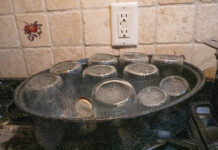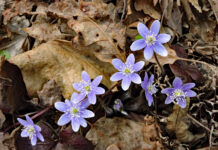
When we first installed our raised bed gardens, I had nothing but produce on my mind. With 16 new plots, I could certainly grow every veggie I’d ever wanted and even try some new things. The first few years were unbelievably productive (thanks to our well-aged mule manure). So much so, that I ended up giving away more than what we ate and even threw out perfectly good food onto the compost pile. Not needing all the space that I originally thought I had, I decided to convert a couple of my beds into flower gardens. The rest is history. Today, only 2 of my raised beds house vegetables, while I pride myself in creating amazing pollinator gardens in all of the others.
Themes
I try to have beds with themes. I have a moon garden that only blooms after dark and attracts amazing sphinx moths that pollinate the blossoms by moonlight. I have several milkweed gardens. One of them houses tall swamp milkweed (Asclepias incarnata) growing down the center while shorter, bright orange butterfly weed (Asclepias tuberosa) flourishes along the edges. I try to keep my common milkweed (Asclepias syriaca) contained to its own bed, as it spreads by rhizomes and would gladly take over the entire garden if given the chance.
I don’t only plant natives but study up on the flowers that will provide the most nectar and benefit the bees and other insects that rely on these resources. I never plant invasive species, however, no matter how tempting. For instance, despite being a butterfly magnet, you will never see purple loosestrife growing on my property!
One of my favorite flowers that I make sure grows in every bed is tall verbena (Verbena bonariensis). While not visually spectacular, its small purple globs of blossoms held up on long stalks up to 6 feet in height, bloom profusely for months on end until the autumn frost, providing an endless supply of nectar that the hummingbird moths just can’t stay away from.
Host plants
In addition to planting a variety of flowers that will attract nectaring insects, I also add plants that will host insect eggs and larvae.
Although fragrant milkweed blossoms entice almost every kind of bee, butterfly and beetle, the plant’s leaves are the only thing on which monarch butterflies will lay their eggs. There is nothing I enjoy more than watching a monarch sip nectar and then fly down onto a milkweed leaf, carefully bending its abdomen down around the edge to deposit a single egg on the underside.
I plant dill and parsley so that the black swallowtails can oviposit on their leaves. I love to see those beautiful black, orange and green caterpillars feasting away as the summer wears on, eventually exiting the plant in search of a sheltered spot in which to spin its chrysalis that will hatch into a gorgeous butterfly just weeks later.
I even plant flowering tobacco (Nicontiana) or tomato plants for the Carolina sphinx moths. Many people despise these “tomato hornworms” but the adult moths are pollinating machines as they travel from flower to flower inserting their long proboscises in search of nectar. For those of you who despise this important insect, please just throw an additional plant or two in the ground to make up for any losses you may accrue from their innocent feeding.
Other features

Of course, my gardens aren’t complete without a few additional features.
Nearby, on the side of our barn, I have installed an array of mason bee boxes. These structures with their many tubes are designed to host several different species of solitary bees. I have been amazed at the success I have had attracting many different species and I especially enjoy watching the tiny leafcutter bees bringing colorful pieces of leaves and flower petals used in nest construction.
I hang a few hummingbird feeders in my garden as well. These birds are obviously attracted to the many flowers but certainly enjoy a free meal at the feeders. Since my garden is in full sun, I find myself changing the sugar solution in these feeders often so that it will not spoil and make the tiny birds sick.
I have also installed a bluebird box in the garden, too, with much success. However, I must limit my time when working in the area of the box when the birds are incubating their eggs. Weeding too close may keep the female off the nest too long.
I have also found that a water feature with a solar fountain is a nice addition, especially during times of drought, when the honeybees pack tightly around the edges, drinking deeply.
As autumn sets in and the dread of a dreary winter begins to invade my mind, I am buoyed by the thoughts of my raised beds. You see, every winter I spend a considerable amount of time designing my gardens. With each bed mapped out, I sit and plan what will go into each one, what seeds I will need to obtain, and how each bed will be configured. I loved laying out the arrangement of my pollinator plants, being careful to put the tallest in the center, working down to the shortest ones in front, and making sure that there are a variety of colors that complement each other. It has become an art and I revel in the hard work every spring, knowing that I will be handsomely rewarded by the colors, the fragrances and the animal activity resulting in a garden coming full circle once again.



















Wonderful article packed with things we can do to help butterflies,bees and even ourselves,to work with,instead of fight with nature.Instead of reaching for a weed killer,research what it is you want to eliminate.Is it dandelion,a food source bees look for in Spring?
Or goldenrod,a “feeding station” for beneficial insects? Tami’s article highlights
many ways we can make our little corner a safer place for insects
that are of benefit to mankind.Thank you for another great article!